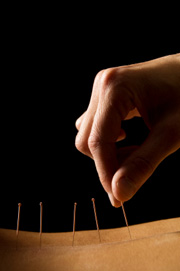Acupuncture
Acupuncture stimulates the production of the body’s own painkillers (e.g., endorphins and enkephalins). It is used to interrupt the pain cycle and promote healing of injuries and chronic pain. Dry needling of your painful areas can interrupt the pain cycle, release tight, knotted tissues, promote blood flow through the damaged area, and allow healing of the tissues to occur. Electric stimulation of the needles helps interrupt the pain signals. Acupuncture is safe and effective. Often patients feel significant relief after one treatment.
Acupuncture is effective for:
- Low back pain
- Sciatica
- Hip pain from arthritis
and bursitis - Shoulder pain from capsulitis,
bursitis, and tendinitis - Headaches
- Arthritis
- Sinusitis
- Foot pain from plantar fascitis
- Elbow pain from tendinitis
and arthritis - Upper back pain from
poor posture - Neck pain from muscular
tension and arthritis - Muscular tension
Study examines acupuncture’s mechanisms of action
http://www.sciencedaily.com/releases/2013/03/130314085528.htm
Is dry needling the same as acupuncture? How does it work? And who needs it? Good questions!
Dry needling involves the insertion of very thin needs into areas of painful muscular, ligamentous, and tendinous damage. Electric stimulation may then be attached to the needle to enhance its effect. The insertion of the needle creates a sensation of aching, which indicates the the area of damage has been located. Dry needling interrupts the cycle of pain and increases circulation to the area of injury. It is a modern technique that has an historical basis in acupuncture. It is remarkably effective and very safe for managing the following conditions:
- Low back pain
- Sciatica
- Neck and upper back pain
- Headaches
- Rotator cuff injuries in the shoulder
- Tendinitis in the elbow, shoulder, and hip
- Knee pain
- Hip pain
- Shin splints
- Plantar fascitis
- Achilles tendinitis
Dry needling can be utilized instead of injections of cortisone. Cortisone weakens tendons and leaves them vulnerable to further tearing and damage. Research shows us that just the needling of the tissue is very effective at interrupting pain and promoting improved circulation. Only in circumstances when this approach is ineffective should shots of cortisone be considered.
Dr. Smith has been using Dry Needling in addition to Acupuncture for over 20 years. She received her certification in Acupuncture in 1993.









